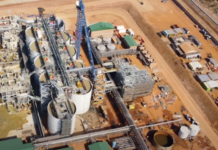
[miningmx.com] – HARMONY Gold is preparing to put its Kusasalethu mine on care and maintenance if it cannot bring a three-month period of lost production, and wildcat violence at the west Rand mine to a halt.
Graham Briggs, CEO of Harmony, said the company had issued a Section 189 notice, a 60-day process that allows for the retrenchment of employees. This comes against a background of serious financial losses at the mine since October.
Briggs forecast Kusasalethu would post a R150m operating loss for the December quarter, and a R252m after-capex outflow. Harmony reports its next quarterly figures on February 4.
The mine, which has the capacity to produce between 260,000 ounces and 300,000 oz, employs 5,193 full-time workers and a further 900 contractors which together cost the company R225m in annual wages. A total of 60,000 people would be affected if the mine was closed which includes dependents and individuals employed in services.
In parallel with the Section 189, a dual process of engagement with labour, which Briggs confirmed is now 62% aligned with the Associated Mineworkers & Construction Union (Amcu), would begin.
Briggs added, however, that negotiations were fraught. “We met with Amcu on Friday at 8am and finished at 11pm without any resolution,’ he said. He said that there had been no basic demands from Amcu and that it was likely Kusasalethu would be excluded from annual wage negotiations which kick off in earnest later this year.
“I have basically given myself six months to get to the solution,’ said Briggs who added that Kusasalethu could restart operations in July after re-employing workers.
Assuming Kusasalethu restarted on time, Harmony’s annual production would be 1.2 million ounces, 100,000 oz below guidance.
“We’re drawing a line in the sand,” said Briggs. A 189 process is a 60-day process. If we don’t get a conclusion the outcome will be fairly obvious,” he added.
Since a 23-day strike ended on October 22, which resulted in 25,000 oz in lost gold production, there had been a climate of violence and disruption at the mine including two murders, the assault of a mine manager, sit-ins, and death threats sent to management, said Briggs.
“Management cannot continue operating. There is an extremely high risk that something will go wrong,” added Briggs. “We’re not prepared to pay for bad behaviour,” he said.
Briggs said other mines in Harmony’s portfolio had not seen similar labour behaviour, but asked how management’s decision to put Kusasalethu on care and maintenance could be interpreted by employees within the rest of the group, Briggs said: “They should look at this as a way to lose their jobs.”
Harmony Gold has said in the past that it wanted to finance its 50% portion of the massive Wafi/Golpu gold and copper project in Papua New Guinea which carries a capital bill in its initial phase of about $4.8bn (increasing to $9bn).
Briggs said the interruption of mining at Kusasalethu, which produces about 14% of total group production, would have no bearing on the future financing of Wafi/Golpu.
“That mine (Wafi/Golpu) will be fundable whether it comes from cash or borrowings. You have to separate the funding of that mine with these problems,” he said.
Shares in Harmony Gold fell 2.87% to R69.45 following the announcement.









